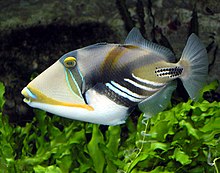Triggerfish
| Triggerfish Temporal range:
| |
|---|---|

| |
| Lagoon triggerfish | |
| Scientific classification | |
| Domain: | Eukaryota |
| Kingdom: | Animalia |
| Phylum: | Chordata |
| Class: | Actinopterygii |
| Order: | Tetraodontiformes |
| Family: | Balistidae A. Risso, 1810 |
| Genera[1] | |
|
Abalistes | |
Triggerfish are about 40 species of often brightly colored fish of the
Anatomy and appearance
The largest member of the family, the stone triggerfish (Pseudobalistes naufragium) reaches 1 m (3.3 ft),[4] but most species have a maximum length between 20 and 50 cm (8–20 in).[2]
Triggerfish have an oval-shaped, highly compressed body. The head is large, terminating in a small but strong-jawed mouth with teeth adapted for crushing shells. The eyes are small, set far back from the mouth, at the top of the head. The
The two
As a protection against predators, triggerfish can erect the first two dorsal spines: The first (anterior) spine is locked in place by erection of the short second spine, and can be unlocked only by depressing the second, "trigger" spine, hence the family name "triggerfish".
With the exception of a few species from the genus Xanthichthys, the sexes of all species in this family are similar in appearance.
| Image | Genus | Living species |
|---|---|---|
 |
Abalistes D. S. Jordan & Seale, 1906 |
|
 |
Balistapus Tilesius, 1820 |
|
 |
Balistes Linnaeus, 1758 |
|
 |
Balistoides Fraser-Brunner, 1935 |
|
 |
Canthidermis Swainson, 1839 |
|
 |
Melichthys Swainson, 1839 |
|
 |
Odonus Gistel, 1848 |
|
 |
Pseudobalistes Bleeker, 1865 |
|
 |
Rhinecanthus Swainson, 1839 |
|
 |
Sufflamen D. S. Jordan, 1916 |
|
 |
Xanthichthys Kaup, 1856 |
|
| Xenobalistes Matsuura, 1981 |
Behavior
The anatomy of the triggerfish reflects its typical diet of slow-moving, bottom dwelling
Some triggerfish species can be quite aggressive when guarding their eggs. Both the Picasso (Rhinecanthus aculeatus) and titan triggerfish (Balistoides viridescens) viciously defend their nests against intruders, including scuba divers and snorkelers. Their territory extends in a cone from the nest toward the surface, so swimming upwards can put a diver further into the fishes' territory; a horizontal swim away from the nest site is best when confronted by an angry triggerfish. Unlike the relatively small Picasso triggerfish, the titan triggerfish poses a serious threat to inattentive divers due to its large size and powerful teeth.[6]
Male territoriality
Triggerfish males migrate to their traditional spawning sites prior to mating and establish territories. Some male species (i.e.
Spawning and biparental care
Triggerfish spawning is timed in relation to lunar cycles, tides, and time of changeover of tides. In relation to lunar cycles, eggs are observed 2–6 days before the full moon and 3–5 days before the new moon. In relation to tides, spawning happens 1–5 days before the spring tide. In relation to timing of tides, eggs are observed on days when high tides take place around sunset.[9]

Male and female triggerfish perform certain prespawning behaviors: blowing and touching.
Mating systems
In crosshatch triggerfish (
Life history
Triggerfish lay their demersal eggs in a small hole dug in the sea bottom. Off Florida, juveniles of some species of triggerfishes are found in floating Sargassum, where they feed on the small shrimp, crabs, and mollusks found there.[12]
Edibility

Some species of triggerfish, such as the titan triggerfish, may be
Gallery
-
The reef triggerfish is the state fish of Hawaii.
-
Most triggerfish are aggressive, but few match the orange-lined triggerfish.[3]
-
Thesexually dimorphictriggerfish. The female lacks the blue throat and yellow fin-edging.
-
The redtoothed triggerfish is one of the relatively few planktivores of the family.
-
Thequeen triggerfishhas elegant extensions to its fins.
-
Adultbanks, but juveniles live around sargassum.
References
- S2CID 15223867.
- ^ ISBN 0-691-00481-1.
- ^ a b c McDavid, Jim (July 2007). "Aquarium Fish: Triggerfish". Advanced Aquarist. Vol. VI, no. VII. Archived from the original on 6 June 2017.
- ^ Froese, Rainer; Pauly, Daniel (eds.) (2015). "Pseudobalistes naufragium" in FishBase. February 2015 version.
- ISBN 3-927991-01-5.
- .
- S2CID 3213367.
- ^ S2CID 35997227.
- ^ S2CID 36747250.
- ^ Kawase, Hiroshi (2003). "Maternal egg care in the bridled triggerfish, Sufflamen fraenatus (Balistidae) at Hachijojima island, Japan". Natural History Research. 7: 193–197.
- ^ Reebs, Stéphan G. (2011–2015). "Are fishes good parents?" (PDF). Université de Moncton. Archived (PDF) from the original on 4 March 2016 – via howfishbehave.ca.
- ISBN 0-12-547665-5.
- ^ Evans, Jade. "How To Cook Triggerfish In The Most Delicious Way". MarvelousChef.com. Archived from the original on 29 July 2017. Retrieved 4 July 2017.
External links
 Media related to Balistidae at Wikimedia Commons
Media related to Balistidae at Wikimedia Commons Data related to Balistidae at Wikispecies
Data related to Balistidae at Wikispecies The dictionary definition of Balistidae at Wiktionary
The dictionary definition of Balistidae at Wiktionary


![Most triggerfish are aggressive, but few match the orange-lined triggerfish.[3]](http://upload.wikimedia.org/wikipedia/commons/thumb/f/f1/Balistapus_undulatus.jpg/120px-Balistapus_undulatus.jpg)



